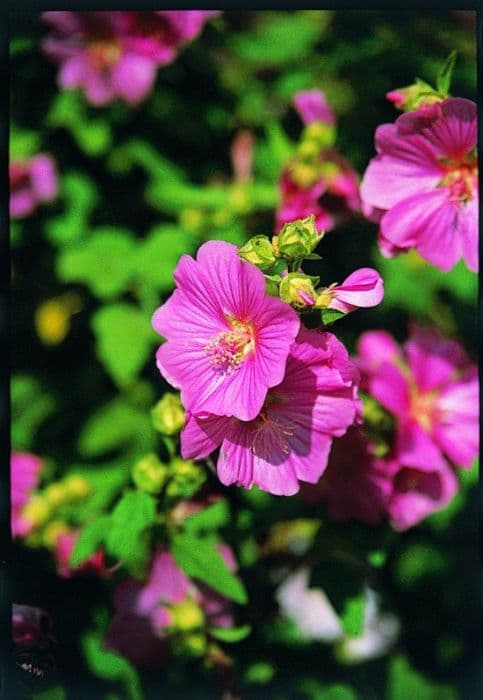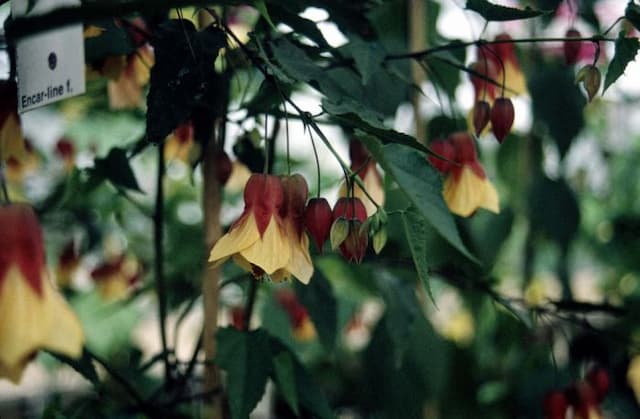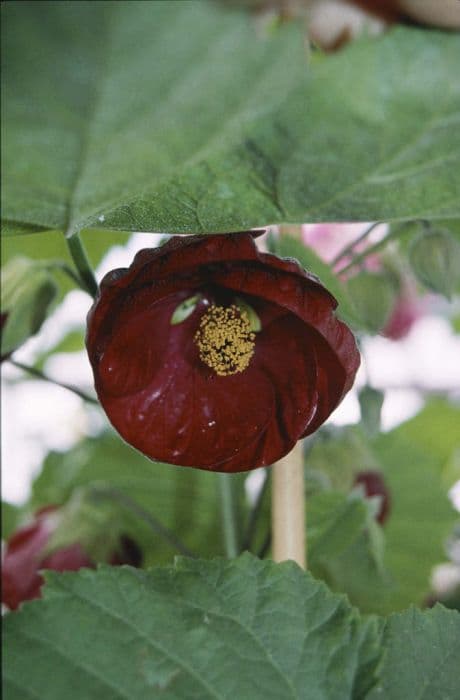Tree Mallow Lavatera × clementii 'Bredon Springs'

ABOUT
Lavatera 'Bredon Springs' is a striking plant known for its abundant blooming and decorative qualities. The plant displays a profusion of pink flowers that are characterized by their hibiscus-like shape, with each bloom showcasing a delicate structure of five petals that often have a darker center or eye, giving them a two-tone appearance. These blossoms are not only large and showy but also attract a variety of pollinators, including bees and butterflies. The leaves of the Lavatera 'Bredon Springs' are equally attractive, with their soft, fuzzy texture and a rich green color. They are typically heart-shaped or slightly lobed, which adds to the overall lush and full appearance of the foliage. The leaves are arranged spirally on the stems, ensuring that the plant looks dense and well-covered throughout the growing season. Overall, the appearance of the Lavatera 'Bredon Springs' is one of charm and vitality, with its striking flowers and full, greenery making it a beautiful addition to any garden. Its blooms are often said to create a romantic or cottage-like feel, and they can also be cut for vases, bringing a touch of outdoor beauty inside the home.
About this plant
 Names
NamesSynonyms
Clementii Mallow, Bredon Springs Lavatera, Bredon Springs Tree Mallow.
Common names
Lavatera × clementii 'Bredon Springs'.
 Toxicity
ToxicityTo humans
Lavatera has no known significant toxicity to humans. While not generally considered poisonous, it is always advisable to exercise caution and avoid ingesting parts of ornamental plants as they're not intended for consumption, and sensitive individuals could potentially experience mild stomach upset or an allergic reaction.
To pets
Lavatera is not commonly listed as a toxic plant to pets. It is generally considered non-toxic to dogs, cats, and horses. Despite this, it's always a good practice to prevent pets from ingesting this or any ornamental plant as it could potentially cause mild gastrointestinal upset if ingested in significant quantities.
 Characteristics
CharacteristicsLife cycle
Perennials
Foliage type
Semi-deciduous
Color of leaves
Green
Flower color
Pink
Height
6 feet (1.8 meters)
Spread
4 feet (1.2 meters)
Plant type
Shrub
Hardiness zones
6
Native area
Mediterranean
Benefits
 General Benefits
General Benefits- Attracts Pollinators: Lavatera × clementii 'Bredon Springs', commonly known as malva or mallow, is attractive to bees, butterflies, and other beneficial insects.
- Easy to Grow: This plant is known for being low maintenance and easy to care for, making it suitable for gardeners of all levels of experience.
- Drought Tolerant: Once established, the mallow is relatively drought tolerant, reducing the need for frequent watering.
- Fast-Growing: Malva plants are fast-growing, providing quick coverage and interest in the garden.
- Long Blooming: Offering an extended flowering period, typically from early summer to fall, it provides lasting color and vibrancy in the landscape.
- Decorative Flowers: The plant produces beautiful, showy flowers that enhance the visual appeal of any garden.
- Versatile: Mallow can be used in a variety of garden settings, including borders, beds, and as a stand-alone feature.
- Wildlife Friendly: In addition to attracting pollinators, it can also provide a habitat and food source for wildlife.
 Medical Properties
Medical PropertiesThis plant is not used for medical purposes.
 Air-purifying Qualities
Air-purifying QualitiesThis plant is not specifically known for air purifying qualities.
 Other Uses
Other Uses- Crafting natural dyes: Leaves and flowers of the Lavatera can be used in a dye-making process to obtain delicate colors for textiles or paper.
- Educational purposes: The plant's growth cycle and pollination process can provide a hands-on learning experience for students studying botany or horticulture.
- Artistic inspiration: Artists might use the blossoms or the general aesthetic of the Lavatera as a motif in paintings, illustrations, or fabric prints.
- Photography: With its showy blooms, Lavatera x clementii 'Bredon Springs' serves as an excellent subject for photographers specializing in botanical and garden imagery.
- Eco-friendly confetti: Dried petals of the Lavatera can be used as biodegradable confetti for outdoor celebrations.
- Flower pressing: The Lavatera's flowers can be pressed and preserved in books or frames, often used in crafts or as delicate bookmarks.
- Bird attraction: The shrub can bring a variety of birds to the garden, who may come to feast on its seeds.
- Insect habitat: The dense foliage offers shelter to beneficial insects, promoting biodiversity in the garden.
- Seasonal decoration: Branches bearing flowers or seed pods may be used in floral arrangements or as part of autumnal decorations.
- Culinary decoration: Edible flowers from the Lavatera can be used to garnish desserts or salads, although their taste is generally bland.
Interesting Facts
 Feng Shui
Feng ShuiThe Tree Mallow is not used in Feng Shui practice.
 Zodiac Sign Compitability
Zodiac Sign CompitabilityThe Tree Mallow is not used in astrology practice.
 Plant Symbolism
Plant Symbolism- Beauty: The Lavatera × clementii 'Bredon Springs', also known as "Bredon Springs," boasts attractive blooms which symbolize aesthetic appeal and grace.
- Resilience: This plant is known for its hardiness and ability to thrive in various conditions, representing the ability to endure and overcome challenges.
- Diversity: The "Bredon Springs" variety, as a hybrid, embodies the concept of diversity, blending qualities from different species into one.
- Romance: With its soft, romantic-looking flowers, this plant is often used to symbolize love and sentimentality.
- Renewal: As a plant that can bloom throughout the season, it symbolizes renewal and the continuous cycle of life and nature.
 Water
WaterThe Tree Mallow ('Bredon Springs') should be watered deeply once a week, allowing for thorough saturation of the soil around the root zone. Adjustments in the watering schedule are required based on weather conditions; during prolonged dry spells or hot weather, increase watering frequency. In cooler weather or if sufficient rain falls, reduce watering. On average, aim to provide about 1 to 1.5 gallons of water per week, ensuring you moisten the soil to a depth of at least several inches. Be cautious not to overwater, as Tree Mallow does not tolerate waterlogged conditions well.
 Light
LightThe Tree Mallow thrives in full sun exposure, meaning it requires at least six hours of direct sunlight daily. It's best to plant it in a location where it can enjoy unobstructed sunlight, as this will promote robust growth and ample flowering. Partial shade is tolerated, but full sun is ideal for ensuring vibrant blooms.
 Temperature
TemperatureTree Mallow prefers moderate to warm temperatures and can tolerate a range from around 50 degrees Fahrenheit to 90 degrees Fahrenheit. Frost can be damaging, so it's important to plant it in an area where temperatures do not regularly fall below 50 degrees Fahrenheit. Ideal growing conditions involve consistent temperatures between 60 and 80 degrees Fahrenheit.
 Pruning
PruningPruning the Tree Mallow should be done in late winter or early spring to maintain its shape and remove any dead or damaged wood. This encourages new growth and can improve blooming. It's usually sufficient to prune the plant once a year, but deadheading spent flowers can be done regularly throughout the blooming season to promote further flowering.
 Cleaning
CleaningAs needed
 Soil
SoilTree mallow prefers well-draining soil enhanced with organic matter. A mixture of garden soil, compost, and sand is ideal. It thrives in a soil pH of 6.0 to 8.0.
 Repotting
RepottingTree mallow, being a large shrub, is generally not repotted. Instead, replace the topsoil yearly if it's in a container.
 Humidity & Misting
Humidity & MistingTree mallow tolerates a wide range of humidity levels and doesn't require any special humidity conditions to thrive.
 Suitable locations
Suitable locationsIndoor
Use large pots, place in bright light, and keep soil moderately dry.
Outdoor
Plant in full sun, enrich soil with compost, ensure good drainage.
Hardiness zone
7-9 USDA
 Life cycle
Life cycleLavatera × clementii 'Bredon Springs', commonly known as tree mallow, begins its life cycle as a seed, which upon germination in early spring, develops roots and a shoot that emerges from the soil. The seedling stage follows, characterized by the growth of the plant's first true leaves and a period of rapid vegetative growth, during which the plant establishes itself. Moving into the juvenile stage, the tree mallow builds a robust framework of stems and foliage and prepares for the onset of flowering. The flowering stage typically occurs in the summer, with the plant producing numerous funnel-shaped flowers that attract pollinators and lead to seed development. After pollination, the plant enters the fruiting stage where seeds develop within the spent flowers, completing its reproductive cycle. With the arrival of fall and colder weather, the tree mallow may die back, entering a dormant phase, especially if it is not winter-hardy in the region it is planted, before resuming growth from its base the following spring.
 Propogation
PropogationPropogation time
Early spring
Lavatera × clementii 'Bredon Springs', commonly known as Bredon Springs lavatera, is propagated most effectively through semi-hardwood cuttings. This method is commonly employed during late summer. To propagate, one selects a healthy, non-flowering shoot and cuts a 4-6 inch (about 10-15 cm) length, ensuring there are several leaf nodes present. The lower leaf nodes should be stripped, and the cut end dipped in rooting hormone before being planted in a well-draining soil mixture. The cutting should then be placed in a sheltered location with indirect light and kept consistently moist until roots have developed and new growth is observed, indicating successful propagation.









